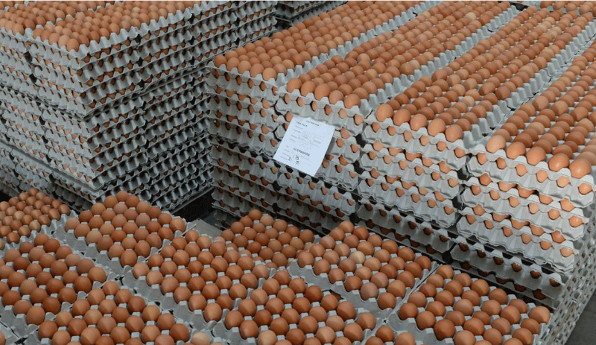I recently saw a web post about the recall of 200 million Eggs being recalled and I thought, “Wow! That must have caused a major Egg shortage in the U.S. Why haven’t I heard about that?” But it turns out that’s just a drop in the bucket. Egg production is a huge industry we all just take for granted!
 Literally mountains of Eggs are produced every day in the U.S., under
Literally mountains of Eggs are produced every day in the U.S., under
more humane conditions than they were a few decades ago.
Think about it: 200 million Eggs. I calculate that, if you boxed them in 12s like you get at the supermarket, you’d need a 50 million cu.ft. / 1.44 million cu. metre cooler to store them in! Nobody has one of those… But nobody needs one, because Egg production is a fluid process. That is, Eggs are trucked out from the farms and packing plants in a steady stream as they are produced. And they are used massively in the packaged and prepared foods industry, not only in whole form, but as auto-cracked, blended liquid eggs, and powdered Egg products. And the flow of Eggs, from farm, to carton, to truck, to store to your fridge, never stops.
Now the real zinger: That 200 million-Egg recall? That was just one day’s output from one farm!
Eggs are indispensable
Eggs truly are an indispensable ingredient in food processing and home cooking. No other single ingredient can act as a substitute for them and, at an average of (US)$0.25 per Egg retail cost, there’s no combination of other ingredients that can do what an Egg does, or deliver the nutrition it offers. Not to mention that your basic Large Egg can be a meal in itself!
Eggs are used massively in baking and slightly less so in other aspects of cooking. You can’t have real Mayonnaise without Eggs. You can’t bake a Cake without 2 Eggs. You can’t have authentic Pad Thai without at least one Fried Egg on top. And the list goes on.
Eggs are healthy again!
For a while in the 80s, Eggs were condemned as concentrated doses of cholesterol and saturated fats, and Doctors recommended restricting one’s intake of them. But, recently, Eggs have been rehabilitated by science and medicine as great sources of protein and other nutrients. There are even Egg brands that contain elevated levels of beneficial Omega-3 and -6 fatty acids, which are proving valuable to maintaining cardiac health. So, go ahead and eat that Egg! Just watch how you cook it and what you cook it in. Therein may lie a rub…
The hens and the environment are healthier, too
Animal rights advocates may dispute it, but The American Egg Board claims, living conditions for commercial laying hens have improved dramatically. The annual mortality rate for laying hens on commercial farms has dropped from around 40 percent to just 18 percent since the Egg Board was established forty years ago.
The Board also reports:
“Despite producing more eggs in 2010, the total environmental footprint in 2010 was 54% – 63% lower than the environmental footprint in 1960. Using 1960 technology to produce the 2010 egg supply would have required 78 million more hens, 1.3 million more acres of corn and 1.8 million more acres of soybeans.”
Eggs may be the only food product that has stayed stable in price or even dropped a little (depending where you live) over that time.
But let’s get back to the numbers…
The Egg Board reports:
“In the major egg producing states, flocks of 100,000 laying hens are not unusual and some flocks number more than 1 million. Each of the roughly 280 million laying birds in the U.S. produces from 250 to 300 eggs a year. In total, the U.S. produces about 75 billion eggs a year, about 10 percent of the world supply.”
“Each year, about 60 percent of the eggs produced are used by consumers, about 9 percent are used by the foodservice industry and the rest are turned into egg products which are used mostly by foodservice operators to make the meals we eat in restaurants and by food manufacturers to make foods like mayonnaise and cakes mixes.”
The overall numbers are almost beyond comprehension!
I got out my calculator again just to see… And found that 75 billion eggs, boxed in dozens, would occupy a space of 18,750 million cu. ft. / 531 sq. metres. That’s more than enough to enough Eggs to cover 325,520 football fields two deep in 12-Egg cartons…
I’ll never take an Egg for granted again!
~ Maggie J.

